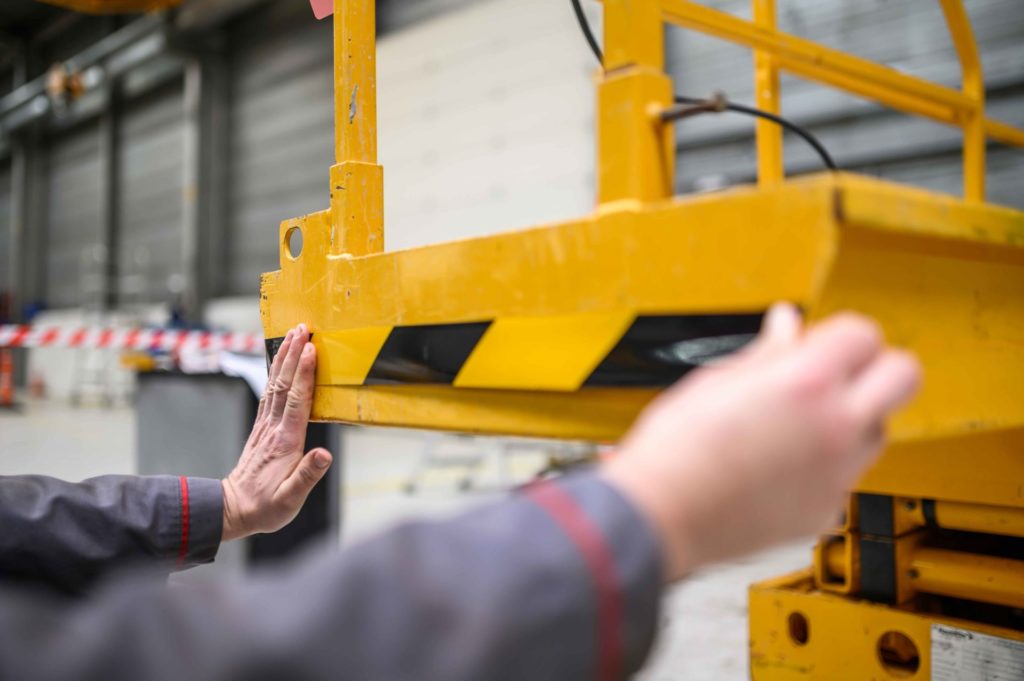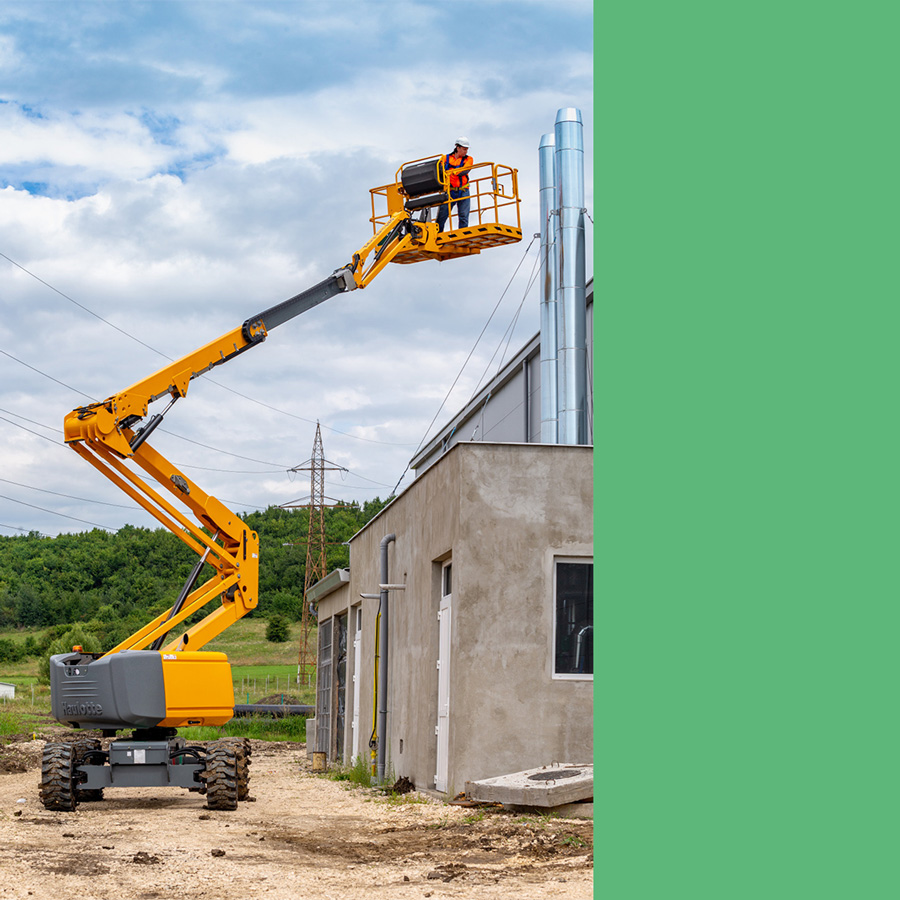The construction and industrial sectors face growing pressure to curb greenhouse gas emissions. Heavy machinery like boom lifts contributes significantly to carbon footprints, mainly through its manufacture and operation. In fact, analyses estimate that up to 75% of a machine’s lifecycle emissions occur during its production and delivery.
This means extending the life of existing equipment and using it more efficiently are powerful strategies for reducing CO₂ output.
1. Choose a reconditioned boom (Restart Program)
Rather than buying new, opt for a reconditioned aerial platform. Haulotte’s Restart program (Europe’s first OEM reconditioning center) completely overhauls used lifts and returns them to “like new” condition.
Using a refurbished lift avoids the raw-material extraction and factory energy needed for a new one. In practice, buying used equipment is literally a form of recycling, it extends the machine’s useful life and eliminates most of the embedded carbon of a brand-new unit. These certified pre-owned machines come with full warranties, so performance and reliability match a new unit.
Explore differences beetween 2nd hand machine and refurbished in our article dedicated to this topic.

2. Refresh and maintain your boom
Keeping a boom well-maintained ensures it runs efficiently for longer. This includes prompt mechanical repairs (fixing leaks, replacing filters, changing fluids, etc.) and even cosmetic refreshes like repainting. As one guide notes, any equipment “requires regular maintenance to perform at its best”. In other words, proactively fixing small issues and tuning the engine/hydraulics prevents wasteful fuel use. Applying a fresh coat of industrial paint protects metal from rust and wear, and routine inspections will catch wear before it worsens. Timely repainting or corrosion repair prolongs the boom’s life, delaying replacement and cutting the embedded carbon of a new purchase. Haulotte refurbishment solutions help to refresh and maintain your MEWP according to the manufacturer’s recommendations.
3 major benefits when refurbishing your MEWP:
- Increase your machines' lifespan
- Your equipment operates at its full potential
- Improved residual value
3. Leverage telematics and data
Modern boom lifts can be fitted with telematics devices that report their health and usage in real time.
Haulotte’s Sherpal telematic solution (and its on-board Activ’Screen) provide remote access to key data: hour meters, battery and fuel levels, engine status, and upcoming service dates. Crucially, Sherpal continuously reads fault codes from the machine’s CAN bus and transmits them, along with likely causes and repair instructions, to a central dashboard.
This means maintenance crews know exactly what’s wrong before they arrive, greatly speeding up repairs. Over time, monitoring hours and compliance (battery charging, filter cleaning, etc.) “increases the lifespan” of batteries and engine parts. In short, data-driven upkeep keeps equipment in service longer with fewer surprises.
4. Equip your boom with a Start/Stop System
Idling a diesel engine in a boom lift still burns fuel and emits CO₂ for no gain. An automatic start/stop system cuts these idle emissions.
For example, Haulotte Stop Emission System detects when the operator is inactive: after roughly 90 seconds of no movement, it shuts off the engine. The moment the operator moves the controls again, the engine restarts instantly. By eliminating needless idling, this system significantly trims fuel use and emissions, Haulotte reports it “allows you to reduce fuel consumption”. On busy sites, avoiding long idling (such as during lifts or repositioning) can noticeably cut a machine’s overall fuel burn without affecting productivity.
5. Switch to renewable diesel (HVO)
For rough-terrain diesel booms, switching to HVO (Hydrotreated Vegetable Oil) fuel can drastically cut CO₂ emissions. HVO is a “drop-in” biofuel made from recycled oils and fats, and it works in any diesel engine without modifications. Because HVO’s carbon comes from recently grown biomass, burning it releases far less net CO₂ than fossil diesel.
Studies show using 100% HVO instead of regular diesel can reduce lifecycle CO₂ emissions by about 80–90%. HVO also produces much lower soot, SO₂ and NOₓ emissions during combustion. In practice, many fleets already use HVO (sometimes called “renewable diesel”) to slash fuel’s carbon footprint while maintaining full power and range.

The switch from diesel to HVO is an opportunity to significantly reduce CO2, NOx and particle emissions. It is fully compatible with Haulotte boom equipped with Internal Combustion engines.
3 major benefits from HVO:
- High-quality fuel with no compromise on engine performance
- Environmental benefits: CO2 reduction by up to 90% over the fuel’s life cycle compared to fossil diesel
- Engine manufacturer warranty is preserved when using HVO instead of diesel (Haulotte)
6. Consider electric booms for Zero-Emission operation
When it’s time to replace a machine, consider going fully electric. Haulotte’s new PULSEO series are battery-powered boom lifts.
They emit no tailpipe CO₂ or pollutants during operation. (They do still have an initial manufacturing footprint, but on-site they produce zero exhaust.) Electric booms also operate very quietly and produce no diesel particulates, making them ideal for indoor work or clean-air zones (e.g. around hospitals or schools). When charged from renewable sources, electric lifts offer a truly clean solution on the job.
Reducing a boom lift’s carbon footprint is all about extending its life and using cleaner energy. Buying certified used machines (via Restart), keeping them in top shape (mechanical fixes and paint), monitoring them with telematics, and cutting idle time all save fuel. Switching to low-carbon fuels like HVO (or going electric) then tackles tailpipe emissions. These steps not only shrink CO₂ output but also lower operating costs. For rental firms, fleet managers or contractors aiming to meet stricter emissions rules and sustainability goals, adopting these measures is a win–win for business and the environment.